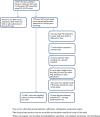Formal and informal venous thromboembolism risk assessment and impact on prescribing of thromboprophylaxis: a retrospective cohort study
- PMID: 37074512
- PMCID: PMC10366250
- DOI: 10.1007/s11096-023-01578-w
Formal and informal venous thromboembolism risk assessment and impact on prescribing of thromboprophylaxis: a retrospective cohort study
Abstract
Background: Hospital-acquired thrombosis (HAT) is a leading cause of preventable death and disability worldwide. HAT includes any venous thromboembolic (VTE) event occurring in-hospital or within 90-days of hospitalisation. Despite availability of evidence-based guidelines for HAT risk assessment and prophylaxis, guidelines are still underutilised.
Aim: To determine the proportion of patients who developed HAT that could have been potentially prevented with appropriate VTE risk assessment and prophylaxis at a large public hospital in New Zealand. Additionally, the predictors of VTE risk assessment and thromboprophylaxis were examined.
Method: VTE patients admitted under general medicine, reablement, general surgery, or orthopaedic surgery service were identified using ICD-10-AM codes. Data were collected on patient characteristics, VTE risk factors, and the thromboprophylaxis regimen prescribed. The hospital VTE guidelines were used to determine rates of VTE risk assessment and the appropriateness of thromboprophylaxis.
Results: Of 1302 VTE patients, 213 HATs were identified. Of these, 116 (54%) received VTE risk assessment, and 98 (46%) received thromboprophylaxis. Patients who received VTE risk assessment were 15 times more likely to receive thromboprophylaxis (odds ratio [OR] = 15.4; 95% CI 7.65-30.98) and 2.8 times more likely to receive appropriate thromboprophylaxis (OR = 2.79; 95% CI 1.59-4.89).
Conclusion: A large proportion of high-risk patients who were admitted to medical, general surgery and reablement services and who developed HAT did not receive VTE risk assessment and thromboprophylaxis during their index admission, demonstrating a significant gap between guideline recommendations and clinical practice. Implementing mandatory VTE risk assessment and adherence to guidelines to improve thromboprophylaxis prescription in hospitalised patients may help reduce the burden of HAT.
Keywords: Thromboembolic prophylaxis; VTE risk assessment; Venous thromboembolism prophylaxis; Venous thrombosis.
© 2023. The Author(s).
Conflict of interest statement
There are no competing interests to declare.
Similar articles
-
A retrospective review of the use of thromboprophylaxis in patients who subsequently developed a venous thromboembolism after discharge from hospital.N Z Med J. 2010 Feb 19;123(1309):37-49. N Z Med J. 2010. PMID: 20186241
-
Venous thromboembolism risk assessment and prophylaxis in hospitalised medical patients in the Cape Town metropole, South Africa.S Afr Med J. 2022 Feb 1;112(2):13506. S Afr Med J. 2022. PMID: 35139994
-
Incidence of Hospital Acquired Thrombosis (HAT) in a Tertiary Care Hospital.Ir Med J. 2017 Apr 10;110(4):542. Ir Med J. 2017. PMID: 28665081
-
Extended thromboprophylaxis in the acutely ill medical patient after hospitalization - a paradigm shift in post-discharge thromboprophylaxis.Hosp Pract (1995). 2018 Feb;46(1):5-15. doi: 10.1080/21548331.2018.1410053. Epub 2017 Nov 30. Hosp Pract (1995). 2018. PMID: 29171776 Review.
-
Antithrombotic Therapy for Venous Thromboembolism and Prevention of Thrombosis in Otolaryngology-Head and Neck Surgery: State of the Art Review.Otolaryngol Head Neck Surg. 2018 Apr;158(4):627-636. doi: 10.1177/0194599818756599. Epub 2018 Feb 27. Otolaryngol Head Neck Surg. 2018. PMID: 29484922 Review.
References
-
- Khan MI, O'Leary C, O'Brien A, et al. Hospital acquired thrombosis (HAT) prevention in an acute hospital; a single centre cross-sectional study. Ir Med J. 2017;110(4):547. - PubMed
-
- Fitzmaurice DA, Murray E. Thromboprophylaxis for adults in hospital. BMJ. 2007;334(7602):1017–1018. doi: 10.1136/bmj.39210.496505.BE. - DOI - PMC - PubMed
MeSH terms
Substances
LinkOut - more resources
Full Text Sources
Medical
Miscellaneous


